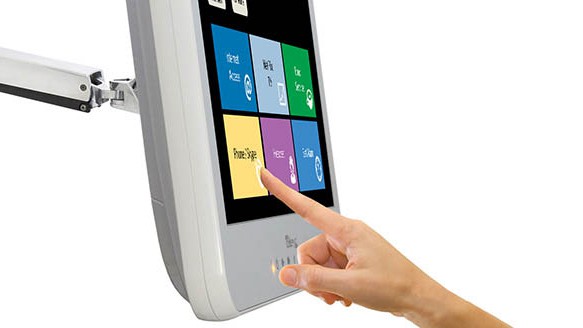A typical healthcare environment is a complex system of devices, networks and people working in-sync, but modern hospitals are increasingly pressed to find cost-saving solutions. Energy efficiency is one of the focal points in health care budgeting. Reducing energy consumption is a priority, but so is digitization and patient satisfaction. The latter two are direct contributors to regulatory compliance and reimbursement. One of the technologies that help hospitals address the issue of adopting high performance, modern IT solutions, digitize and cut costs and energy use at the same time is Power over Ethernet.
Power over Ethernet, PoE, is a set of networking standards. It enables a four-wire Ethernet network cabling to provide electrical power and data to a device. IP phones, IP surveillance cameras, and Wi-Fi access points are widespread applications of PoE.
Energy Efficiency
Article Guide
One of the key benefits of PoE-enabled computers is the long-term cost saving effect they have on the power consumption. A typical All-in-One PC that is frequently found in POC wall-mount kiosks in hospitals consumes 65+ watts. A PoE-enabled computer consumes less than 30 watts. That is 50% less than a standard AIO machine. When you calculate the savings an entire facility can generate, the advantage becomes apparent.
More to the point of energy efficiency, PoE-enabled computers are turned off completely when they are off, i.e. no adapters or switches remain powered on, passively consuming energy when the device is not in use.
Installation & Scalability
PoE, unlike USB or Firewire, allows much longer cable lengths. If USB or Firewire allow up to 5 meters/15 feet, PoE supports up to 100 meters or ~300 feet cable length. The advantage here is the ability to mount a PoE-enabled device in places where conventionally-powered devices can’t fit due to cable length restrictions, or where electric outlets are hard to reach or add.
Depending on the Ethernet cabling, PoE can support a higher wattage of up to 25.5 watts per device, allowing the devices to meet their power requirements.
Introducing new equipment is expensive and time-consuming due to how challenging it can be to adjust the existing architecture. Scalability of PoE systems is much greater than that of the conventional systems and allows for a simpler and more effective installation and distribution of network connections on the network.
It is cheaper and simpler to deploy Ethernet cable data points than to mount additional AC outlets, as a typical electrical installation of a single device is $200-$750 on average.
There is less need for additional circuit breakers, transient, harmonics and surge filters and maintenance for Power-over-Ethernet devices. There is a variety of manufacturers of network switches with PoE+ support, so local network administrators can handle the installation, add mid-span injectors between a non-PoE switch and PoE network devices. The majority of managed PoE injectors and switches allow the admin to monitor power consumption or recycle it to individual ports.
Flexibility
Flexibility and ergonomics are critical for many settings. PoE-enabled computers are not tethered to an electrical outlet, so can be located where they are needed most. Relocating a PoE-enabled computer is equally easy.
Standardization
Standardization is another benefit of PoE. Since PoE is standards-based, interoperability across brands is guaranteed. Another aspect of standardization is consolidating the fleet of devices on a standard network. This is equally important for hospitals and industrial environments alike when a single, secure network infrastructure facilitates deployment, maintenance, and control of a large fleet of devices. This enables greater reliability, manageability and translates into seamless collaboration and improved quality of service across a facility.
Reliability
PoE-enabled computers provide greater reliability, as power and data come from a central, universally-compatible source instead of being dependent on a mix of distributed wall adapters. Such systems enable seamless device control, so when the need arises you can reset or disable a device remotely.
Safety and Uptime
Safety of PoE computers is another key advantage, as PoE delivery is intelligent and protects the network equipment from incorrect installation, under powering or overload. Such systems are backed-up by an uninterruptible power supply, which means your computers are up and running 24/7, irrespective of the power outages. A single, central UPS eliminates the need for an individual UPS per each device so that the fleet of devices remains operational.
Data Protection
Security and privacy of EHR systems are a serious consideration. Protecting EHRs from unauthorized access is an important part of HIPAA compliance for hospitals. Again, PoE computers have an advantage, as they have a network switch controlled remotely. Since there is only one power input source, PoE computers can be turned on only if the network permissions are correct. The administrator can turn on or shut down individual computers or systems remotely via Wan or LAN, adding another layer of protection, and preventing unauthorized access.
PoE computers that come with an integrated barcode scanner, RFID reader, biometric reader, CAC or Smart Card reader make use of advanced authentication methods that restrict the access to confidential information to authorized personnel only.
More so, the network can be configured to monitor and record where and when PoE computers are used. A detailed log of device usage creates a wealth of actionable data that can be used to boost security.
The optimal PoE computer is Windows-based, though, because Win OS offers the most of what modern-day encryption and privacy filter technologies can provide. It is highly recommended to encrypt the data end-to-end, at rest and in transit, in the cloud and locally, as well as on external carriers.
Performance Requirements
Power-over-Ethernet computers operating in healthcare facilities must provide high performance, HD video, and a powerful graphics processing card. EHR systems are demanding, so the machines must be powerful enough to run them beside the patient infotainment systems.
Ergonomics matters. Compact size, minimum footprint and wire clutter, flexible mounting options must be backed by an all-in-one build that incorporates all discreet parts of high quality and 24/7 reliability for 5+ years. Thus, the components must be MIL-STD certified. The collateral effect of a minimized wiring and MIL-STD certifications is the increased patient safety, as there are no wires to trip over, and electrical or radiation hazards are addressed.
Antimicrobial* properties protect the PoE computer casing from deterioration and degradation.
With all considerations addressed, a PoE computer becomes a cost-effective enabler of modern hospitals’ transition to digitization, EHRs, greater patient satisfaction, safety, security and compliance. Significant installation, deployment, maintenance and energy savings paired with a low failure rate of less that 2% make the TCO of a Power over Ethernet medical PC a deal breaker.
How Medical Computers Are Revolutionizing the Healthcare Industry
October 4, 2015
Medical computers manage patients’ information and allow functions like writing & tracking prescriptions, managing patient billing and tracking all aspects of a patient's medical care. Medical computers are…
0 Comments6 Minutes
Patient Infotainment – The Benefits of Utilizing Bedside Computers
February 25, 2016
We as a thinking species have evolved in more complex ways than one. In terms of our understanding and accepted definitions of technology, for instance. In the new globalized lives we lead today, ‘medicine’ has evolved…
0 Comments4 Minutes
You Can't
Learn from a Pop-up
But we can deliver knowledge to your inbox!
We dive deep in the industry looking for new trends, technology, news, and updates. We're happy to share them with you.
Knowledge, News, and Industry Updates Right in Your Inbox




